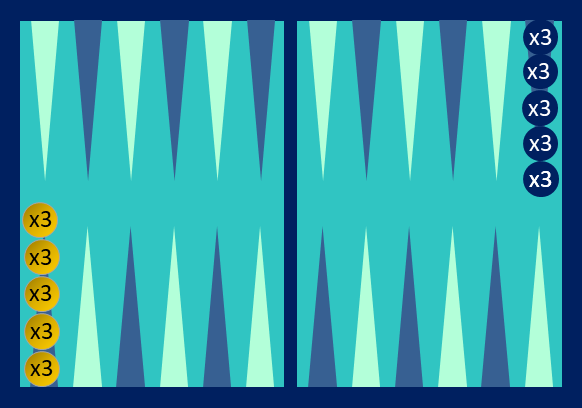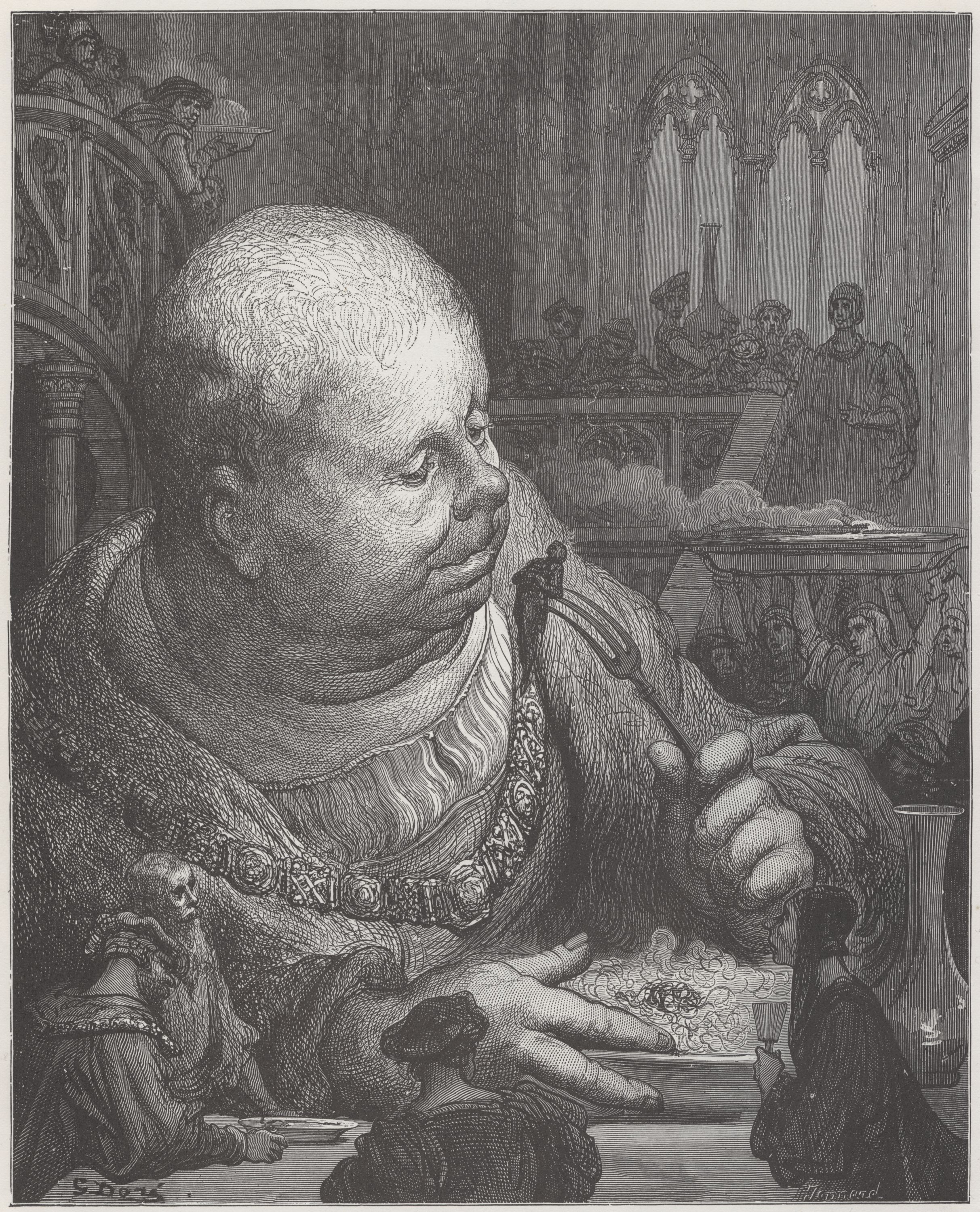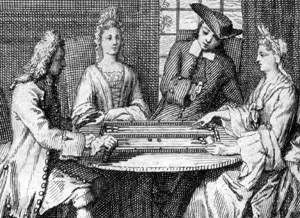|
Tourne Case
Tourne Case or Tourne-Case is an historical French tables game in the same family as Backgammon. Lalanne recommends it as a children's game. Some sources suggested that the name originated in the fact that a counter that was 'hit' had to be returned (''retourner'') to the box (''case'') or Trictrac table. However, Fallavel suggests it is more likely to mean "Point of Three" i.e. refers to the final point on which three counters must be placed to win. History The game is mentioned by Rabelais in Gargantua in 1532Rabelais (1532). and its rules are recorded in French games compendia from the end of the 17th century to the late 19th century. A variant called La Course en Ligne Droite is also recorded in the late 20th century.Lêchalet (1979), pp. 18–20. Equipment Like all tables games, Tourne Case requires a tables board made up of two rows of twelve points in the shape of triangles, three counters called pieces or men for each player, as well as two dice cups and two dice. The ... [...More Info...] [...Related Items...] OR: [Wikipedia] [Google] [Baidu] |
Board Game
Board games are tabletop games that typically use . These pieces are moved or placed on a pre-marked board (playing surface) and often include elements of table, card, role-playing, and miniatures games as well. Many board games feature a competition between two or more players. To show a few examples: in checkers (British English name 'draughts'), a player wins by capturing all opposing pieces, while Eurogames often end with a calculation of final scores. '' Pandemic'' is a cooperative game where players all win or lose as a team, and peg solitaire is a puzzle for one person. There are many varieties of board games. Their representation of real-life situations can range from having no inherent theme, such as checkers, to having a specific theme and narrative, such as ''Cluedo''. Rules can range from the very simple, such as in snakes and ladders; to deeply complex, as in ''Advanced Squad Leader''. Play components now often include custom figures or shaped counters, and distin ... [...More Info...] [...Related Items...] OR: [Wikipedia] [Google] [Baidu] |
Jacquet (game)
''Jacquet'' is a tables game, played on the same type of board as Backgammon, that was once very popular in France and several other parts of Europe. It probably emerged around 1800, but is attested by 1827.''Histoire des Jeux de Société'', Jean-Marie Lhôte, Ed. Flammarion In the 20th century it replaced the classic French backgammon the game of until Jacquet itself was superseded by Anglo-American games in the 1960s. History Jacquet emerged around 1800 to become "the benchmark for tables games in France" gradually superseding Trictrac, the game that symbolised the Ancien Régime, and ousting it almost entirely by the end of the 19th century. The oldest known rules were published in 1818 by Lepeintre. During the 19th century, confusion existed in French sources which sometimes equated Jacquet to Backgammon, but a distinctive feature was that the majority of pieces or men could not be moved until the first one, the courier, had reached the fourth quarter of the board. Other ... [...More Info...] [...Related Items...] OR: [Wikipedia] [Google] [Baidu] |
Games Of Chance
A game of chance is in contrast with a game of skill. It is a game whose outcome is strongly influenced by some randomizing device. Common devices used include dice, spinning tops, playing cards, roulette wheels, or numbered balls drawn from a container. A game of chance may be played as gambling if players wage money or anything of monetary value. Alternatively, a game of skill is one in which the outcome is determined mainly by mental or physical skill, rather than chance. While a game of chance may have some skill element to it, chance generally plays a greater role in determining its outcome. A game of skill may also may have elements of chance, but skill plays a greater role in determining its outcome. Gambling is known in nearly all human societies, even though many have passed laws restricting it. Early people used the knucklebones of sheep as dice. Some people develop a psychological addiction to gambling, and will risk even food and shelter to continue. S ... [...More Info...] [...Related Items...] OR: [Wikipedia] [Google] [Baidu] |
Board Games
Board games are tabletop games that typically use . These pieces are moved or placed on a pre-marked board (playing surface) and often include elements of table, card, role-playing, and miniatures games as well. Many board games feature a competition between two or more players. To show a few examples: in checkers (British English name 'draughts'), a player wins by capturing all opposing pieces, while Eurogames often end with a calculation of final scores. ''Pandemic'' is a cooperative game where players all win or lose as a team, and peg solitaire is a puzzle for one person. There are many varieties of board games. Their representation of real-life situations can range from having no inherent theme, such as checkers, to having a specific theme and narrative, such as ''Cluedo''. Rules can range from the very simple, such as in snakes and ladders; to deeply complex, as in ''Advanced Squad Leader''. Play components now often include custom figures or shaped counters, and distinc ... [...More Info...] [...Related Items...] OR: [Wikipedia] [Google] [Baidu] |
Tables Games
Tables games are a class of board game that includes backgammon and which are played on a tables board, typically with two rows of 12 vertical markings called points. Players roll dice to determine the movement of pieces. Tables games are among the oldest known board games, and many different varieties are played throughout the world. They are called 'tables' games because the boards consist of four quadrants or 'tables'. The vast majority are race games, the tables board representing a linear race track with start and finish points, the aim being to be first to the finish line, but the characteristic features that distinguish tables games from other race games are that they are two-player games using a large number of pieces, usually fifteen per player. Tables games should not be confused with table games which are casino gambling games like roulette or blackjack. Name The word 'tables' is derived from the Latin ''tabula'' which primarily meant 'board' or 'plank', but also ... [...More Info...] [...Related Items...] OR: [Wikipedia] [Google] [Baidu] |
Gargantua
''The Life of Gargantua and of Pantagruel'' (french: La vie de Gargantua et de Pantagruel) is a pentalogy of novels written in the 16th century by François Rabelais, telling the adventures of two giants, Gargantua ( , ) and his son Pantagruel ( , ). The work is written in an amusing, extravagant, and satirical vein, features much erudition, vulgarity, and wordplay, and is regularly compared with the works of William Shakespeare and James Joyce. Rabelais was a polyglot, and the work introduced "a great number of new and difficult words ..into the French language". The work was stigmatised as obscene by the censors of the Collège de la Sorbonne, and, within a social climate of increasing religious oppression in a lead up to the French Wars of Religion, it was treated with suspicion, and contemporaries avoided mentioning it.Le Cadet, Nicolas (2009) Marcel De Grève, La réception de Rabelais en Europe du XVIe au XVIIIe siècle', Cahiers de recherches médiévales et humanistes ... [...More Info...] [...Related Items...] OR: [Wikipedia] [Google] [Baidu] |
Tables Game
Tables games are a class of board game that includes backgammon and which are played on a tables board, typically with two rows of 12 vertical markings called points. Players roll dice to determine the movement of pieces. Tables games are among the oldest known board games, and many different varieties are played throughout the world. They are called 'tables' games because the boards consist of four quadrants or 'tables'. The vast majority are race games, the tables board representing a linear race track with start and finish points, the aim being to be first to the finish line, but the characteristic features that distinguish tables games from other race games are that they are two-player games using a large number of pieces, usually fifteen per player. Tables games should not be confused with table games which are casino gambling games like roulette or blackjack. Name The word 'tables' is derived from the Latin ''tabula'' which primarily meant 'board' or 'plank', but also ... [...More Info...] [...Related Items...] OR: [Wikipedia] [Google] [Baidu] |
Trictrac
Trictrac is a French board game of skill and chance for two players that is played with dice on a board (game), game board similar, but not identical, to that of backgammon. It was "the classic tables game" of France in the way that backgammon is in the English-speaking world.Parlett (1999), p. 86. Trictrac's gaming interest lies in its multiple combinations, the importance of decision-making and its comprehensive rules which have been well documented and remained stable since the early 17th century. It requires constant attention from the players whether or not it is their turn. Its vocabulary, which is very rich, frequently occurs in French literature. The object of the game is not to get out the men as quickly as possible as in Jacquet (game), jacquet or backgammon, but to score as many points as possible. The game usually ends before all the men have been borne off. The name is sometimes spelt tric trac or tric-trac. History Trictrac was very popular in France at the roy ... [...More Info...] [...Related Items...] OR: [Wikipedia] [Google] [Baidu] |
Backgammon
Backgammon is a two-player board game played with counters and dice on tables boards. It is the most widespread Western member of the large family of tables games, whose ancestors date back nearly 5,000 years to the regions of Mesopotamia and Persia. The earliest record of backgammon itself dates to 17th-century England, being descended from the 16th-century Irish (game), game of Irish.Forgeng, Johnson and Cram (2003), p. 269. Backgammon is a two-player game of contrary movement in which each player has fifteen piece (tables game), pieces, known traditionally as 'men' (short for 'tablemen') but increasingly known as 'checkers' in the US in recent decades. These pieces move along twenty-four 'point (tables game), points' according to the roll of two dice. The objective of the game is to move the fifteen pieces around the board and be first to ''bear off'', i.e., remove them from the board. The achievement of this while the opponent is still a long way behind results in a triple wi ... [...More Info...] [...Related Items...] OR: [Wikipedia] [Google] [Baidu] |
Race Game
Race game is a large category of board games, in which the object is to be the first to move all one's pieces to the end of a track. This is both the earliest type of board game known, with implements and representations dating back to at least the 3rd millennium BC in Egypt, Iraq, and Iran; and also the most widely dispersed: "all cultures that have games at all have race games". Race games often use dice to decide game options and how far to move pieces. Types of race games Race games may be categorized by their ratio of luck to skill. Other classifications include geographical distribution or derivation; and shape of track (including spiral, cross and circle, and square—either boustrophedon as in Snakes and Ladders or "labyrinthine" as in Thaayam). Simple Simple race games involve pure luck. Each player has only one piece to move, and the outcome of the game thus depends solely on chance. The Game of the Goose is the progenitor of most simple Western race games, whereas ... [...More Info...] [...Related Items...] OR: [Wikipedia] [Google] [Baidu] |
Probability
Probability is the branch of mathematics concerning numerical descriptions of how likely an Event (probability theory), event is to occur, or how likely it is that a proposition is true. The probability of an event is a number between 0 and 1, where, roughly speaking, 0 indicates impossibility of the event and 1 indicates certainty."Kendall's Advanced Theory of Statistics, Volume 1: Distribution Theory", Alan Stuart and Keith Ord, 6th Ed, (2009), .William Feller, ''An Introduction to Probability Theory and Its Applications'', (Vol 1), 3rd Ed, (1968), Wiley, . The higher the probability of an event, the more likely it is that the event will occur. A simple example is the tossing of a fair (unbiased) coin. Since the coin is fair, the two outcomes ("heads" and "tails") are both equally probable; the probability of "heads" equals the probability of "tails"; and since no other outcomes are possible, the probability of either "heads" or "tails" is 1/2 (which could also be written ... [...More Info...] [...Related Items...] OR: [Wikipedia] [Google] [Baidu] |


.jpg)




